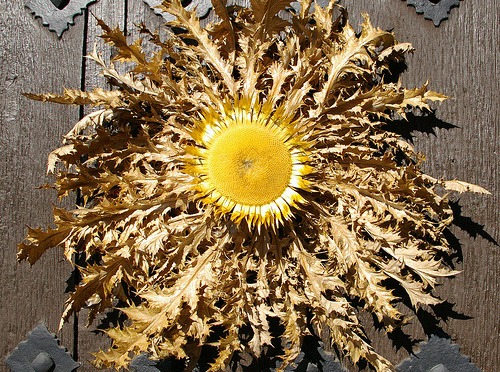We fear the night. Monsters, bad guys, and evil can hide in the dark. We avoid that darkened street corner, not sure what might be hiding in the shadows. The ancient Basques had those same fears, though perhaps their monsters were a bit different. They appealed to their goddesses for relief. And the eguzkilore was created…

- Eguzkilore literally means sunflower. However, the word actually refers to two different plants – Carlina acaulis and Carlina acanthifolia – neither of which are the sunflower we are familiar with. They are more of a thistle and grow low to the ground. One unique aspect of these plants is that they don’t wither once plucked but retain much of their form. They take two years to flower once planted and their oil is known for their aromatic properties, being used to treat acne and eczema.
- However, the eguzkilore is more famous for its beauty and mythological importance. The flower is characterized by the central head adorned by rays of white petals. This is surrounded by a set of thorny leaves. The head closes when it rains to protect its pollen, which was used to predict rainstorms.
- In Basque folklore, Amalur or alternatively Mari created the eguzkilore to protect humans, at their behest, against monsters and evil in the night. She first created the moon, but the evil spirts got used to it. She then created the sun, but that only helped during the day. Ultimately she created the eguzkilore so people would have protection at night. People would affix dried flowers to their doors, representing the light of the sun, which would repel evil. It would also protect against witchcraft.
- The eguzkilore is found mainly in central Europe, in the Pyrenees and Cantauri mountains, between June and September. It usually grows on hillsides, pastures or meadows. Today it is a protected flower, so cannot be cut or taken from the wild. Due to changing weather and overconsumption, it is now classified as a rare or endangered plant.
- Carlina acaulis gets its name from Charlemagne, who in searching for a cure for the plague, had a dream in which an angel told him to shoot an arrow into the air. Whatever plant the arrow hit when it came back to earth would provide a cure.
A full list of all of Buber’s Basque Facts of the Week can be found in the Archive.
Primary sources: Eguzki-lore, Wikipedia
Discover more from Buber's Basque Page
Subscribe to get the latest posts sent to your email.



Yes, the eguzkilore is the stemless carline thistle.
The tall bright yellow sunflower from which we obtain cooking oil is called ekilore, eki, like eguzki, meaning “sun”. cf ekialde – the east.
Witches are deterred by the eguzkilore because they have so much trouble counting the little florets in the centre of the flower.
The house I live in is called Eguzki Lore, has a flower head on the front door, and we’ve never been troubled by sorceresses.